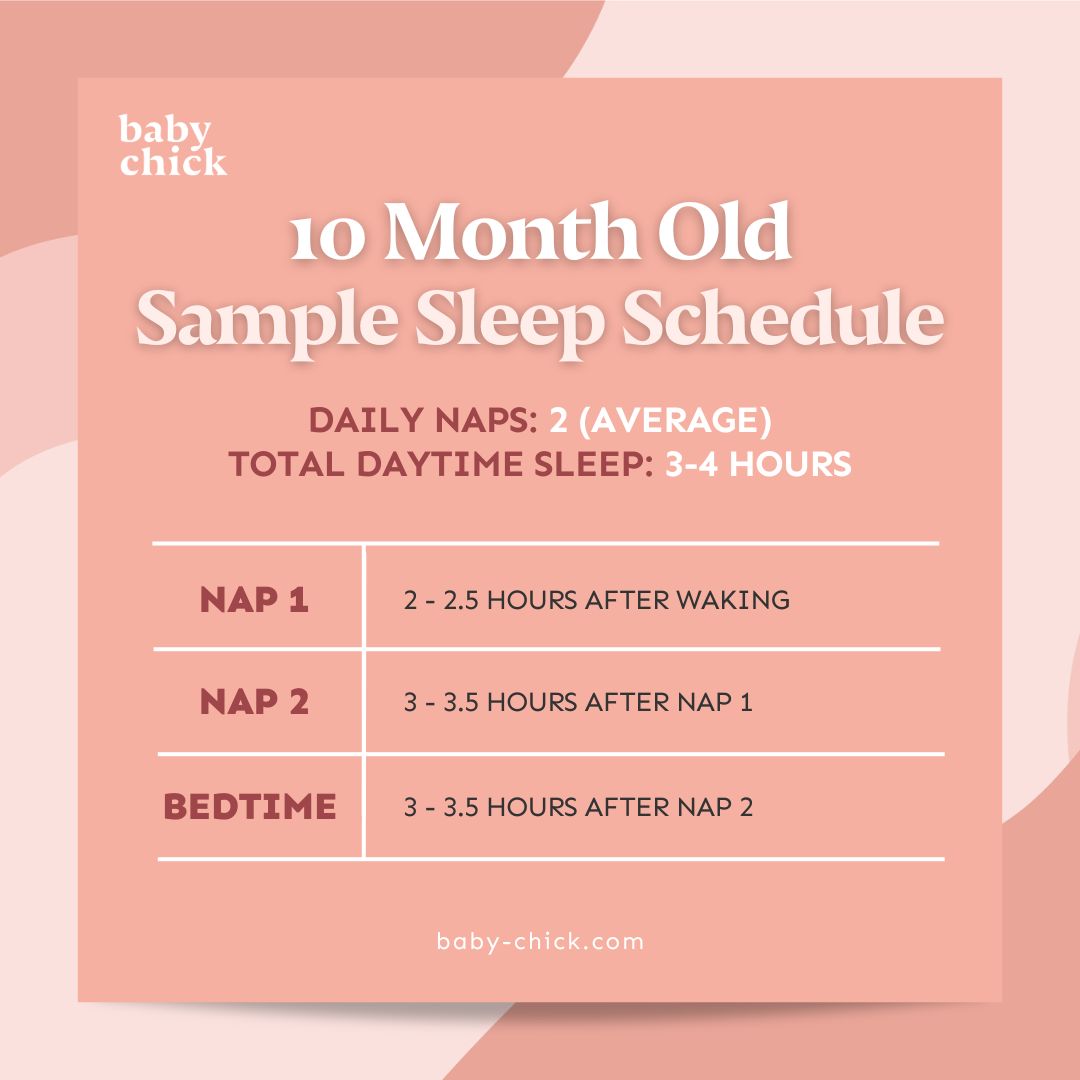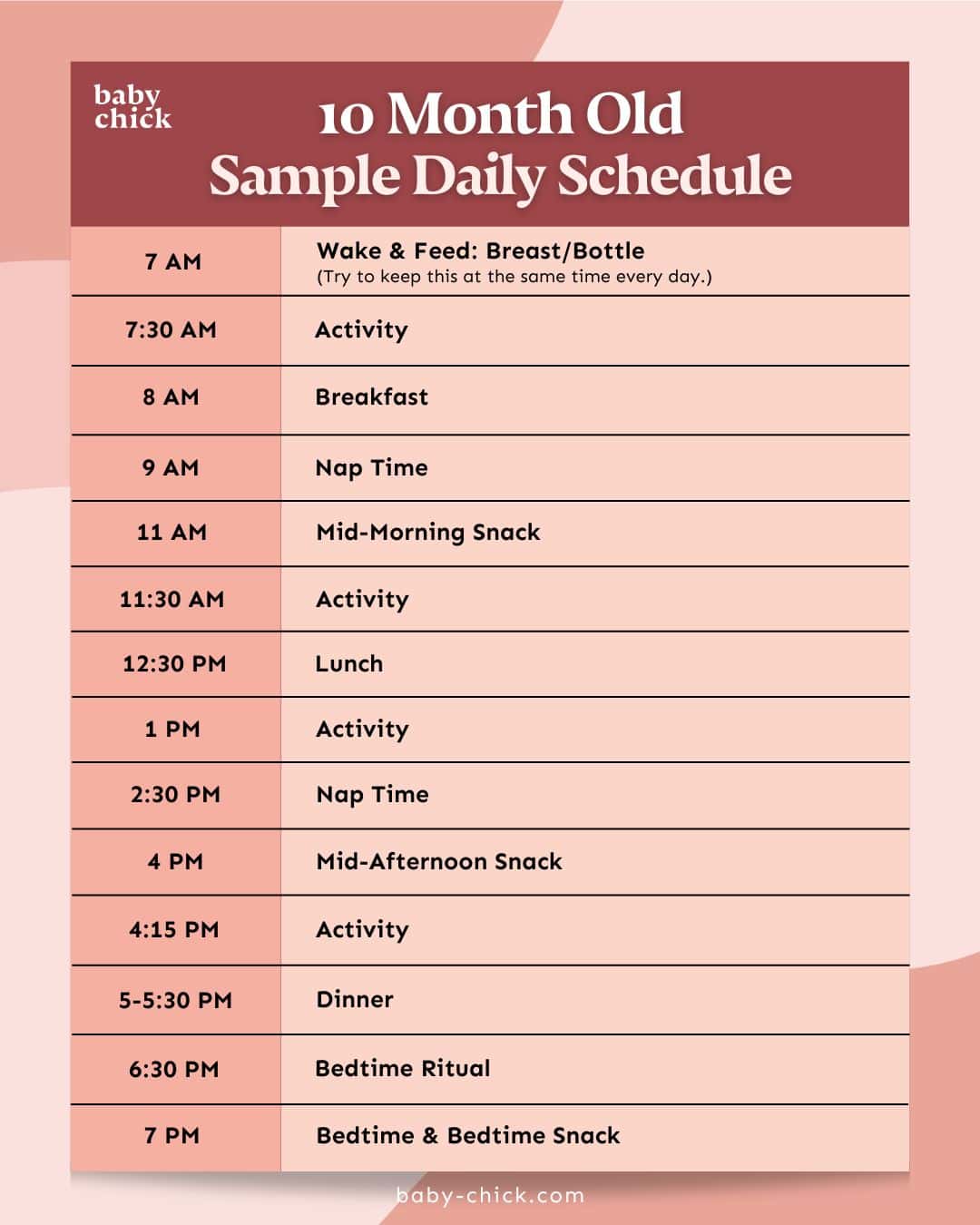You’ve almost made it through the first year of your baby’s life! This year has flown by with your baby learning many new milestones and skills. They’ve learned to sit up and babble and, hopefully, are sleeping more regularly. As your baby approaches 10 months old, they’ll reach even more new milestones. This article will help prepare you for their milestones, skills, and emerging appetite. We’ll cover your 10-month-old’s sleep and feeding schedule, whether they may experience sleep regression, activities you can do together, and more.
10-Month Developmental Milestones
Now that your baby is 10 months old, their activity and noise level will continue to increase. Gone are the days of placing them on a blanket and knowing they’ll stay there! Your baby is on the move, and not much is safe from their reach. Here are some of the new developmental milestones you’ll watch your 10-month-old-baby achieve:1
- Sitting unassisted
- Pulling up to stand using furniture or other objects
- Creeping or crawling
- Walking around furniture while holding on for support
- Feeding themselves using the pincer grasp (grasping food using their thumb and forefinger)
- Banging blocks, toys, or pans together
- Waving bye-bye or shaking their head “no” when asked a simple question
- Saying “dada,” “mama,” and “uh-oh”
- Developing object permanence (the idea that an object still exists even when they can’t see it)
10-Month-Old Feeding Schedule

With all this new movement, your baby will have quite the appetite. While they may start to increase the amount of solid foods they eat, they still require some of their diet to be breast milk or formula. They should consume roughly 12-24 ounces of breast milk or formula daily.2 Now is a great time to introduce new textures and foods into your baby’s diet.2 Your baby will start feeding themselves, so make sure you serve them small pieces of soft foods.3
Your 10-month-old baby’s feeding schedule will look very similar to the current schedule you follow, with a few more snacks thrown in. It’s essential to include various proteins (such as eggs, cottage cheese, small strips of chicken or fish, yogurt, or avocados), whole grains, and fruits and vegetables.2 To give you an idea of what your baby’s daily menu will look like, here’s an example of a 10-month-old’s feeding schedule:2
Breakfast
- ¼-½ cup of grains, such as infant cereal
- ¼-½ cup of mashed/pureed fruit
- ¼-½ cup of protein or one scrambled egg
- 2-4 oz of breast milk or formula
Mid-Morning Snack
- ¼-½ cup of mashed/pureed vegetables
- 2-4 oz of breast milk or formula
Lunch
- ¼-½ cup of protein
- ¼-½ cup of yellow or orange vegetables, such as cooked carrots
- 2-4 oz of breast milk or formula
Mid-Afternoon Snack
- Soft crackers
- ¼-½ cup of protein, such as cottage cheese or yogurt
Dinner
- ¼-½ cup of protein, such as very small pieces of ground meat
- ¼-½ cup of mashed green veggies
- ¼-½ cup of grains, such as pasta, rice, or infant cereal
- ¼-½ cup of mashed/pureed fruit
- 2-4 oz of breast milk or formula
Bedtime Snack
- 2-5 oz of breast milk or formula
10-Month-Old Sleep Schedule

Many parents wonder how much sleep their 10-month-old baby needs in a day. At this age, babies need 12-16 hours of sleep daily. That’s typically split between two to three daily naps and a stretch of nine to 12 hours of sleep at night. Each nap will last anywhere between 30 minutes to two hours, depending on your baby’s habits.3
At 10 months old, your little one may experience another episode of sleep regression. Sleep regression occurs when your baby has a change in their sleeping habits. They can have increased periods of fussiness during the night or trouble falling asleep. Various things can cause sleep regression, but some of the most common reasons include:4
- Teething pain
- Learning a new skill like crawling
- Experiencing separation anxiety
- Going through a growth spurt
- Illness or travel disrupting their schedule
While sleep regression is challenging for both parents and babies, the good news is that it doesn’t last long. Periods of sleep regression typically last two to six weeks, and there are ways to help your little one overcome it:4
- Recognize their sleep cues and put them to bed at the first sign of tiredness, such as a yawn or rubbing their eyes, to help prevent them from getting overtired.
- Keep a consistent bedtime routine and time for sleep.
- Make sure they’re getting their daily naps.
- Give them extra attention during the day and at bedtime if they’re experiencing separation anxiety.
- It’s okay to allow them to fuss for a few minutes in the middle of the night before soothing them (if that feels right for your family).
- Some parents limit cuddling, rocking, and nighttime feeding since these activities can encourage frequent awakening.
Daily Schedule

By this age, you and your baby have undoubtedly developed a daily routine that works for both of you. Your baby’s feeding schedule is starting to match more with the rest of the household, and their sleep schedule has become more predictable. Your 10-month-old will still take two naps daily, but their wake windows will become longer as their energy levels increase. Aiming for a bedtime that allows nine to 12 hours of uninterrupted nighttime sleep helps ensure your baby has the energy needed for the coming day.3
Health Concerns to Watch Out For
There are no routine well-child check-ups or scheduled vaccines at this age, but there are still a few things you need to watch out for. These include concerns with their weight, development, or illness:
Weight Concerns
Parents often wonder how much their 10-month-old should weigh because they don’t have a well-child check-up. An excellent way to monitor your baby’s weight is to look at their growth over the last few months. A 10-month-old baby should be on track to triple their birth weight by 12-15 months.7 They do this by gaining an average of 13 ounces per month.3
Developmental Milestone Concerns
While all babies reach their developmental milestones at different rates, it’s still essential to monitor your 10-month-old for any delays in their development so they can receive proper interventions. Here are some concerns to watch out for:1
- They don’t crawl, or they drag one side of their body while crawling.
- They can’t stand, even with support.
- They don’t use gestures, such as waving bye-bye or shaking their head “no.”
- They don’t babble.
- They’re unable to point at objects or people.
If you notice these signs, please speak to your baby’s doctor.
Illness Concerns
Babies are notorious for putting things in their mouths; that’s how they explore! However, this also leaves them open to illness. Your baby will get sick at some point in their first year, so knowing what symptoms to watch out for is helpful. These symptoms include:5
- Change in their appetite or refusal to eat several feeds in a row
- Change in their behavior, like being extra sleepy or hard to wake up or crying more than usual
- Temperature higher than 102 F that lasts longer than a day
- Fever lasting longer than three days
- Diarrhea that lasts longer than a week or vomiting that lasts longer than a day
- Signs of dehydration, such as decreased tears, decreased wet diapers, and a dry mouth
- Straining to stool or hard pellet-like stools
- Blood in the stool or urine
- Trouble breathing, cold symptoms lasting longer than 10 days, or a cough lasting more than one week
- Ear pain
- An unexplained rash or a rash accompanied by a fever
Contact your doctor if your baby is experiencing any of these symptoms.
Activities for 10-Month-Olds

With all the newfound movement and noise your little one has discovered, playing with them will continue to get sweeter and sweeter. One activity you can do with your 10-month-old is reading. They might like to read books with you and may even try to “read” along. Your child will enjoy babbling with you as you tell them what’s happening around them.1
They’ll also get a kick out of experimenting with a spoon at mealtimes. Most of the food won’t make it into their mouths, but making a mess is the best way for them to learn how to feed themselves independently.3 In addition, you should let them play with moving toys, such as balls and toy cars. This will allow them to discover how different objects move.3
Safety Tips
Safety has never been more critical than it is now. Your baby is increasing their mobility daily, and with that increase in mobility comes an increased risk of harm. To reduce the risk of injury for your baby, here are a few safety tips:1,6
- Move poisonous cleaners, choking hazards, and breakable objects out of reach.
- Attach gates to stairways.
- Pad the corners of sharp furniture, and anchor all furniture to the wall.
- Place window guards on all windows.
- Put baby in their playpen, crib, or highchair while you’re cooking or doing other activities where you can’t give them your full attention.
- Empty all water from the bathtub after use, and never leave baby unattended in the bath or pool.
- If you have a pool, fence it in on all sides.
- Use a rear-facing car seat.
- See our baby-proofing checklist
You now have a mover on your hands! Your baby will only continue expanding their environment and interactions with it. And you’ll be right there with them, helping them along the way. Hopefully, this article has given you a better sense of your 10-month-old baby’s development and what milestones to look out for. Get your running shoes on because there’s no slowing down from here on out!

































